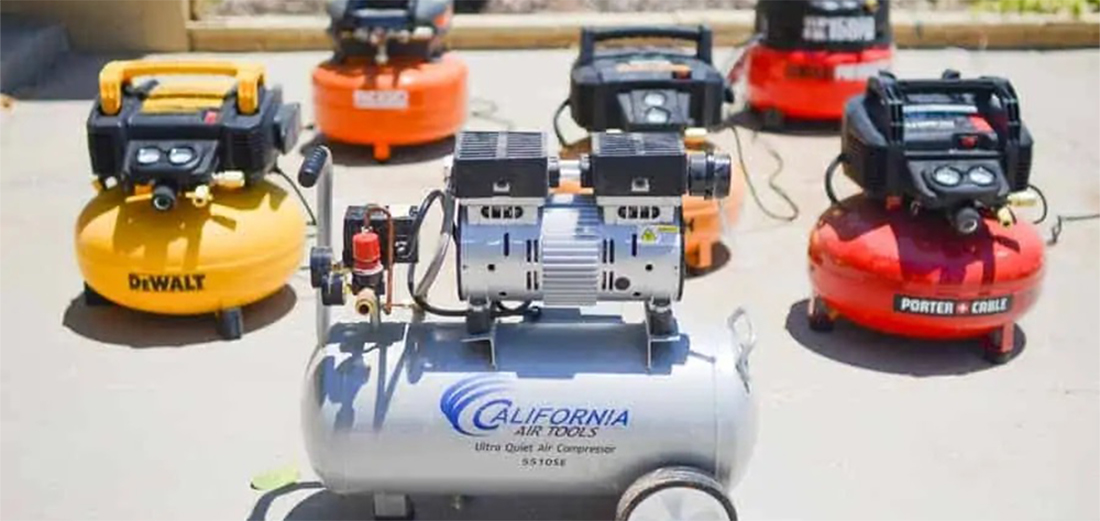
For the best air compressor for a home garage purchase, it’s worth digging into detail, as this is a great long-term investment. With this device, keeping your car, lawn mower, bicycle, and another mechanism with tires, afloat is hassle-free. As well as powering up a range of pneumatic tools. Still, the unit’s size and output will determine a set of tools it can operate with. The list can be limited to the simple staplers and tools for finishing with ⅜-inch tips or expanded to the impact wrenches with a larger diameter and airbrushes.
To get the right model for your needs, check what parameters are crucial for these devices:
- Output rating. Check both the required pressure (measured in PSI) and the CFM rating (that is important for operating some air-driven tools). The device’s CFM rate must be higher than the tool’s you’re planning to air power.
- Motor capacity. Look at both the horsepower and the amperage. The latter will define if you need the circuit breakers (in case the amperage is close to or above 15 amps). The horsepower defines how long it can keep the peak pressure and when it’s time to get your tank full with air again.
- Gallons. For the spot-on household tasks, you’ll require up to 3 gallons only. For the construction, DIY, and carpenter works, about 5–10 gallons or more will be needed.
- Portability. See if the airing compressor fits the assigned spot in your garage, what kind of wheels it has, and a carrying handle. For the cord, the longer the better.
Discover more about the tool’s particulars and check the selected garage air compressor reviews! Buy wisely!
Reviews of the Air Compressor for Home Garage
Craftsman CMEC6150K — Best quietest air compressor for garage
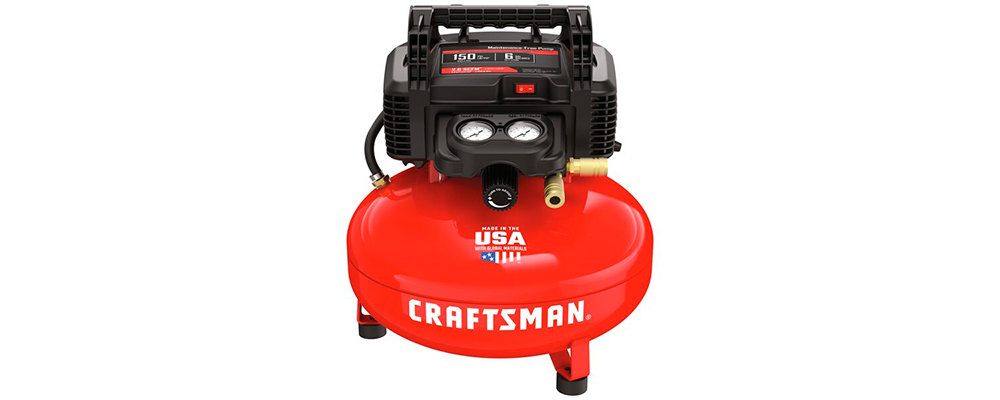
This pancake device is powerful enough to serve various household tasks. It can inflate high-pressure SUV tires quickly. You can hook up your air-powered stapler or a finish nailer to it as well. Priced low, this model can serve as the best air compressor for a home garage well. Still, it’s not the quietest one: the CMEC6150K can become irritating for people around you, emitting 82dB of noise.
The device’s tank is metallic, featuring a 6 gal capacity. The motor is located within a plastic upper part, reliably fastened to the tank. It can emit up to 150 PSI, with the regular workout of 2.6 SCFM at 90 PSI. So you can get your deflated tire back to normal in about 2-3 minutes. Although its pressure may be insufficient for the hard-duty pneumatic drills and saws, this compressor fits lots of tools up to 3 SCFM (for the sporadic short-term usage). The pressure can be set up via a large knob located in front of the two gauges. The left one indicates the compressor’s tank state, and the right one—the output pressure.
The useful feature of this air source is two hose connections, letting you use two tools or inflate two small tires at once. Overall, this unit is inexpensive, solid, and provides a handy design and quick operation. Well worth the best home garage air compressor tag.
Pros
- I liked that the handle is solid, and holds the device reliably.
- I put the compressor on the tile, and it stood in place well. Thanks to rubberized feet.
- The device doesn’t need maintenance (no oil change required), good for non-techies.
Cons
- Rubber airline between the tank and upper part gets hot quickly.
- The depressurizing valve is on the bottom, downward-facing, which isn’t convenient. Remember, don’t turn the device upside down.
Video Craftsman CMEC6150K
Bostitch BTFP02012 — Best portable air compressor for home garage
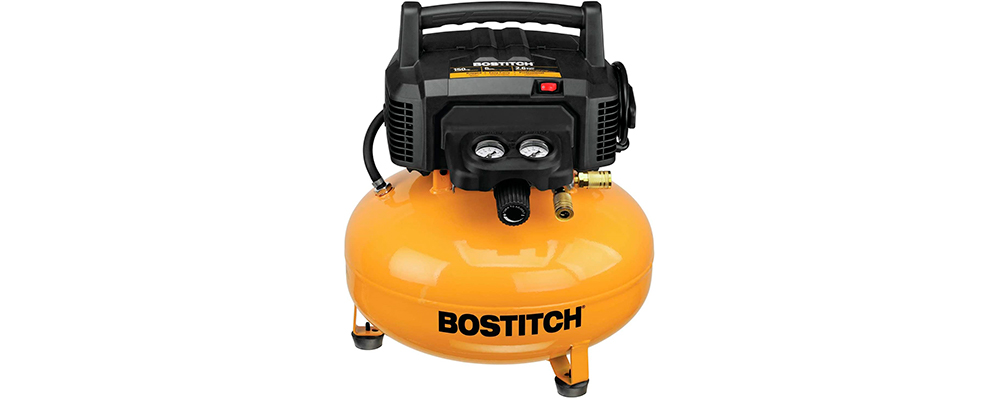
While the specs of this pancake airing device match many of its competitors, the BTFP02012 has gained a competitive advantage. Placed atop, the compressor part is large. The hose outlets, gauges, and a dial knob are located on a top panel facing up. The unit weighs only 29lbs, so you can move it without effort with the sturdy handle. The latter doesn’t sit too low and fits for hands of different sizes. This model can easily become the best portable air compressor for a home garage. Still, it has its shortcomings, such as a rather short power cord of 5 ft. It will let you work only near the outlet or make you apply the extension cord, which could decrease the power output and, thus, the final PSI output number.
The power rating of this air blower reaches 0.8 HP, which is quite average. However, the optimized high-output construction lets it provide the peak 150 PSI for 2 consecutive minutes. Thus, you can connect two tools like a brad nailer and, let’s say, a small-to-middle air wrench, and use them at once for short-duration work. The compressor regains the pressure quickly, so interruption won’t be likely attributed to low-pressure issues. Still, the PSI might get lower if applying two air tools at once.
The motor is quite powerful, letting you deal with the cold temperatures. It starts at 35F as fast as usual. There’s no oil change foreseen for the pump, making it a good option for the best garage air compressor. The hose connections are solid gold-plated ones with a regular diameter.
Pros
- Emitting 78 dB, the compressor’s work is comparable to a regular city traffic noise. It didn’t bother my neighbor within 70ft.
- The motor part has large ventilation slots keeping the device cool. You can touch it anytime without fear
- Using one coupler, you don’t have to cover another, as it seals on its own.
Cons
- The regulator isn’t precise enough: I’ve set it to 90 PSI but really gotten only about 75-80 PSI. Set the dial to 10-15 PSI higher than you hope for.
- Depressurizing the tank can affect your ears. It’s a very loud and shrill sound
Video Bostitch BTFP02012
Porter-Cable C2002
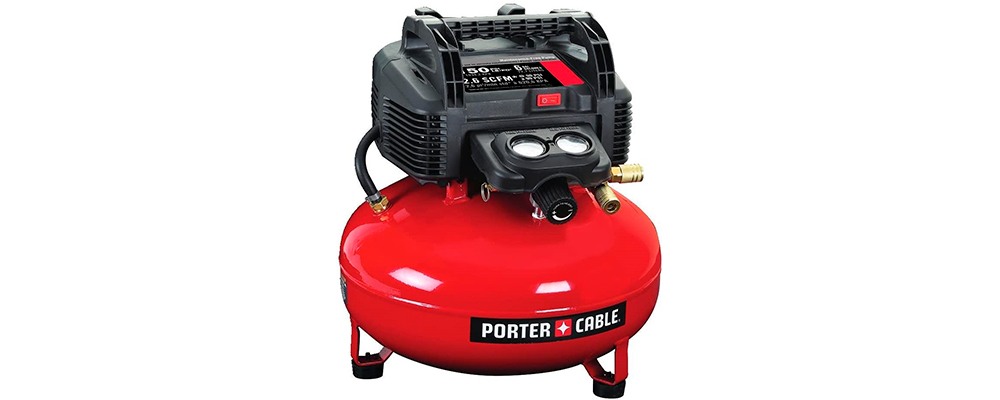
A steel 6-gallon bowl and a high-power motor make this model a worthy pick for the best air compressor for garage use. It can turn on hassle-free at as low as 0 F degrees and doesn’t consume much energy. The low amperage (10 amps) lets you hook it up with the extension cords and keep the output flow stable. The latter is estimated at 150 peak PSI, and 2.6 SCFM are filled quickly at 90 PSI. The unit can maintain such efficiency for quite a long time. So, you can inflate the four tires on your SUV without interruption at all.
The unit can work continuously and doesn’t lose capacity. It’s a no-load work to power two wood nailers at once in about half an hour. There are two hose connectors placed perpendicularly, letting you hook up your pneumatics without messing with the hoses. The flow-measuring gauge is a single one (showing the total output through both hoses), and another one serves for the tank pressure indication. The workhorse motor efficiency is somewhat compensated by the loud operation. This model emits 82db and is comparable to other electric-powered tools in its noise level.
The model isn’t bulky, becoming a good choice for the best garage compressor. It weighs 30lbs and can be carried along easily thanks to a handle. The latter is built into the upper part of the unit. Both parts are sturdy: the upper one is made of solid plastic, and the bowl is built of metal.
Pros
- This model can sustain the air painting gun demand for a short-term period (up to a few minutes). Fits for painting small surfaces or if you apply the quickly drying paints.
- The rubber feet stabilize the whole body and keep the surface non-marred. My tiles have stayed clean even after a bit of dragging the device along.
- The C2002 builds the high pressure immediately. I got the 120 PSI almost immediately, and it didn’t fall less than 90 PSI within 10 minutes.
Cons
- The carrying handle is low-profile. I couldn’t easily insert my large hand between it and the body to grasp.
- The manual isn’t detailed. For example, there’s no indication for a depressurizing procedure. Had to consult the online guide.
Video Porter-Cable C2002
Dewalt DWFP55126
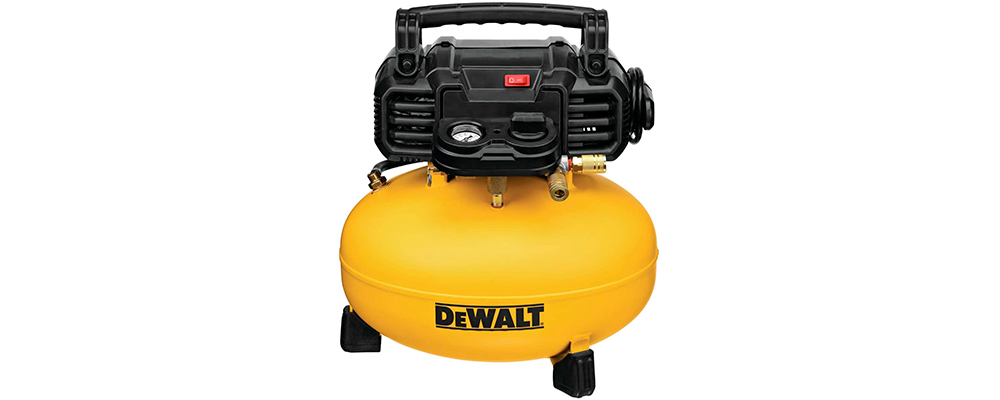
The typical Dewalt solidity is obvious in this 6-gallon pancake air blower. The tank is a thick metallic bowl, and the motorized part features good-quality plastic. Each joint and switch is sturdy, ensuring the DWFP55126 serves for a long time. Its high output lets you implement it in a wide assortment of pneumatic works. For example, for the semi-sized nailers, and even airbrushes. I could well rate this model as the best air compressor for home garage use because the value given by this device totally corresponds with the cost of above-average models.
The unit is fitted with a powerful 10 Amp motor able to produce 165 PSI and maintain this rate for a long time (at no load). While the average output flow makes 2.6 SCFM being filled at 90 PSI, the airing device is able to work at the rate closer to a peak one. Powering an ⅛-inch finish nailer and a pneumatic stapler at once isn’t an issue for it. It doesn’t get hot immediately, like many of its competitors, due to the big ventilation slots and time-proven motor construction.
The top panel features a front dial knob, two hose ports, and two meters. The latter lets you know the flow and tank pressure. The flow capacity can be regulated with a dial. The latter is quite accurate, letting you airpower any gun or object for as much as you need.
This garage air compressor is notable for its low noise disturbance. The device’s sound level doesn’t exceed 76 dB at a maximum load, so it can be mixed up for a regular TV / radio output.
Pros
- The model integrates a cord wrap. It lets you store the cable neatly.
- The feet are fully covered with thick rubber. I didn’t experience any skating and / or vibration during the airing.
- The manual is exhaustive and simple. Each procedure and part are described in detail.
Cons
- Portability isn’t sound. A handle is a non-ergonomic one, and the tank tends to hit my thigh when I carry it along.
- The fitting of accessory hoses doesn’t look reliable. The small bearings inside seem to wear and / or displace quickly.
Video Dewalt DWFP55126
California Air Tools 8010
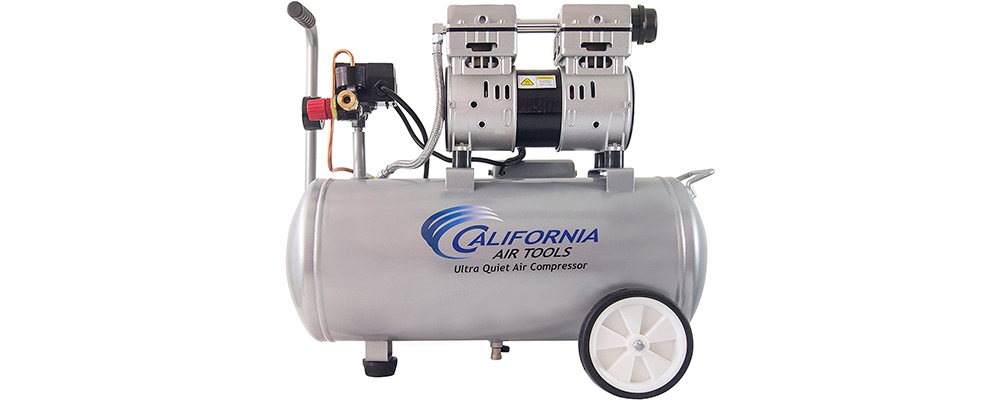
If you live in a busy neighborhood and perform DIY-grade projects, this device might be the best compressor for a home garage. It’s quite compact while having a big tank and solid construction. Besides, it’s also energy-saving, consuming just 8.5 amps during the motor operation.
The motor of this air device is located within the upper part of the mechanism. It fills the 8-gallon tank in less than 3 minutes. The compressor provides a steady output, with a peak of 120 PSI. Its efficiency is estimated at 2.2 SCFM at 90 PSI. The horsepower rating makes 1 HP (which surpasses many competitors’ ratings) and suffices to run your small air sprinkler or a cleaner.
The whole body is metal, making the unit 100% suitable for heavy-duty use. It also integrates the overheat prevention mechanism, fixing the motor if excessive heat is indicated.
Featuring the special silencing filter, located at the air outlet, this unit is probably the quietest air compressor for a garage, among current market offers. It makes noise up to 60dB that equals your neighbors’ conversation next door.
The weight of this unit reaches 48lbs. Still, its portability is higher than many lightweight models have. Two big wheels let you move it along your place, and you can use two handles (front and rear) to maneuver the device, lift, or carry it.
Pros
- You can use it under various weather conditions, including a cold environment. I had good output at 30F.
- The pressure meters have legible dials. You can read them from 6 feet.
- Two sturdy feet are rubberized and let you put the device on multiple surfaces without marring issues.
Cons
- There’s a single air hose connector only. Regrettable at such a high power (as I could’ve powered two guns at once).
- The overall built quality leaves something to be desired: the rubber stop mount is poorly made and the weld seams aren’t accurate.
Video California Air Tools 8010
Makita MAC700 — Best small air compressor for garage
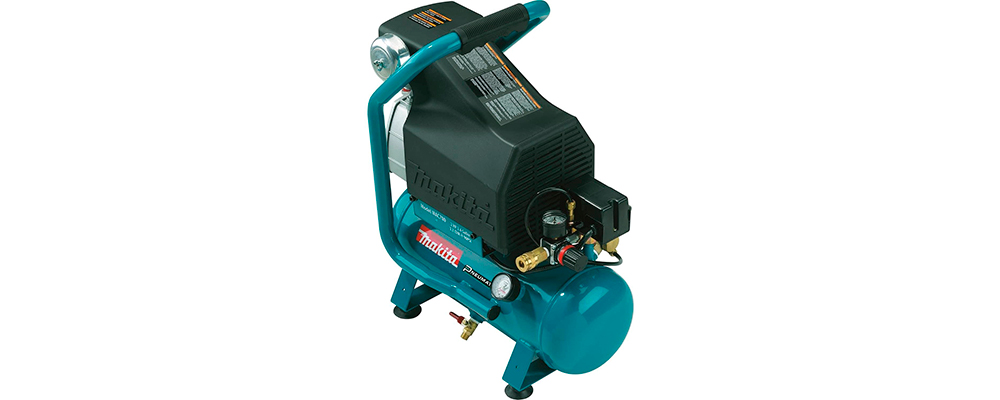
If you’re up to a large DIY project or looking to operate the airbrush or a powerful cleaner, the MAC700 is worth considering. This device doesn’t take much space but features innovative engineering decisions, letting it power up the tools with a 3.3 SCFM rating. This unit can be the best small air compressor for a garage if seeking high output. However, you should mind its lubrication requirements, as it’s not a maintenance-free model.
The compressor is built in a hotdog style featuring a 2.6-gallon tank made of steel. The tank has a thick metal handle, welded to its sides and making a counterweight to the enormous compressor part atop the tank. The latter is mostly metal, with accurate joints and easily reachable valves, meters, and connectors.
The well-readable pressure gauge is located above the output regulator and a sturdy gold-plated hose connector. The tank features a petcock-type valve, making it fast and simple to release the air. There’s also an emergency release valve on the back of the compressor, under the power on / off switch.
The motor of this unit has a high 2 HP rating and consumes 12.48 amps. It rushes the air through a widened bore fast, letting the compressor produce up to 3.3 CFM at the level of constant 90 PSI. The peak output makes 130 PSI, and the compressor can maintain this pressure for a minute without hassle.
The wider bore and lubricated motor of this garage air compressor make it work with little noise. It produces up to 79dB, which is a lot quieter than other models of the same capacity.
Pros
- The tank pressure gauge is located directly on the tank providing the most accurate readings. I could control the pressure fully during the operation.
- The intercooler tube prevents condensate build-up. This makes up for stable output and fewer dehydration procedures.
- The integrated air filter provides for clean air output. Important for sensitive tools like painting guns.
Cons
- The compressor weighs 60lbs having no wheels. It’s very awkward to move around or carry somewhere.
- The pressure regulator is made of plastic. It’s located on the front and can be exposed to occasional bumps.
Video Makita MAC700
Makita MAC2400
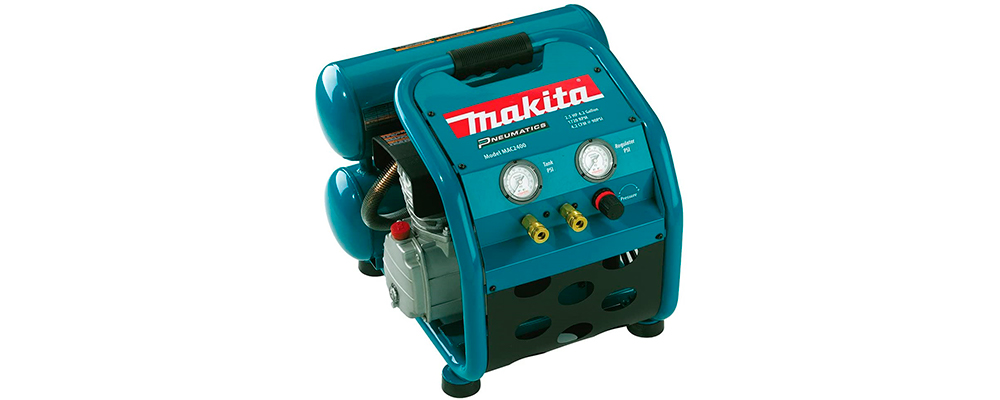
If you’re about to remodel your garage or perform the other construction / carpenter works, the MAC2400 is the right air compressor for the garage. It’s an excellent tool providing a steady high output through the two outlets simultaneously. It draws little power and doesn’t require the installation of the circuit breakers. It’s not too portable though, so ensure your hoses and electric cables are long enough if you’ve decided to buy this model.
The MAC2400 has a heavy-duty build with all the inner mechanics (motor and pump) encased in steel and additionally protected by the metal panel. Such design lets you use the device practically anywhere without being afraid of the occasional bumps, or dust and water getting in.
The compressor can power up the majority of the household tools, including the impact wrenches and sheathing staplers. Its motor has 4 poles and works at 2.5 HP drawing as little as 12.3 amps from the circuit. The pump incorporates the wide bore system. The latter provides for low RPM and high capacity (4.2 CFM at steady 90 PSI), with a peak of 130 PSI. The double steel tanks can store 4.2 gallons of air.
The unit is equipped with a smart cooling system, including the copper tubes with fins for air passthrough, serving as intercoolers. The mechanism requires lubrication, which is easy to perform thanks to an oil level gauge and an easy-to-access oil cap.
In spite of its size and output rating, this garage compressor isn’t too loud. The maximum noise level reaches 79dB, which is comparable to less powerful models.
Pros
- The unit features a solid non-sliding and non-vibrating design. I stood still during the high-load work I threw it at.
- The pressure meters are low-profile, and the pressure valve is located on the front panel. Convenient to throw a quick glance and know the output.
- The carrying handlebar is sturdy and embraces the casing to ensure safe shifting. It feels like you carry the whole device, not just the upper part.
Cons
- This model is quite heavy (weighs 77lbs), too wide, and bulky for being carried effortlessly.
- The manual’s explanation of how to set up the device for the first time is confusing. Not a beginner-friendly type.
Video Makita MAC2400
California Air Tools 10020C

The 10020C model from the CAT manufacturer has many features that make it a good choice for a garage. Although it’s not an industrial-grade device like the Ingersoll Rand P15IUA9 Garage Mate air compressor, it has similar parameters and even outperforms the latter in terms of efficiency. Both compressors have 2-HP motors but implement different pumping systems. The Ingersoll Rand requires constant lubrication, while the CAT is maintenance-free. The CAT 10020C has a 10-gallon tank, which is three times less than the capacity of the Ingersoll Rand Mate Garage. Still, it can produce 5.3 CFM at 90 PSI, while the Garage Mate ends up with 5.0 CFM.
Implementing the dual-piston system, the 10020C compressor has an efficient heat dissipation and provides for low-RPM motor work. This makes it suitable for working in different climate conditions, as it starts easily. The motor is a 14-amp one, so it’s safe to plug it into the regular home outlet.
The front panel of this home garage air compressor features twin connectors, letting you operate your ⅜-inch air impact tools or nailers two at once. The meters indicate the pressure, which can be regulated by the firm red dial. The safety valve is located there as well, for easy reach in case of emergency.
The compressor is quite compact but tall and heavy (82.5lbs). Still, it has good portability thanks to a topside rubberized handle and two middle-sized plastic wheels on the front bottom.
Pros
- This model is very quiet for its size and output (70dB). No disturbance to your household and neighbors even during a long work.
- An integrated overheating protector is featured. It ceases the motor operation if the mechanism gets too warm.
- The device recovers the maximum pressure in 25 seconds (from 90 to 120 PSI). It let me operate the airbrush without interruption within 3 minutes.
Cons
- The quick-fit couplers seem somewhat wobbly during the hose connection. It makes you double check if the connection is solid.
- Welding isn’t accurate in some places (e.g. at the handlebar). Not crucial but aesthetically unpleasant.
Video California Air Tools 10020C
Buyer’s Guide
Garage Air Compressor Setup
Depending on the size and weight of your model, the air compressor setup in a garage might take fewer or more steps. You can move a small pancake compressor around easily, while the massive pro-grade model will require thorough preparation. In general, you should take the following steps for a proper garage air compressor setup:
- Determine the place. Make sure the surface is flat and there’s enough space around the compressor (to prevent the heat from building up). Proper light is also crucial for checking the meter readings quickly.
- Put a rubber pad or an analog on the floor to stabilize the compressor.
- Check if the power cord is long enough or you’ll need the extension one
- Make sure that the air hose would reach your tools and let you operate them conveniently.
- Connect the tool and turn on the compressor. Then start the air-driven gun.
Selection of a Proper Hose
The hose should fit your compressor connector and be long enough for you to operate your tools. Still, the longer the hose is, the more PSI will be lost at the final output. Try to select the best place for an air compressor at a home garage so that the hose length wouldn’t exceed 50ft. Ensure the hose capacity is no less than 150 PSI.
Filter
Before screwing in or inserting a hose, attach a filter to the air outlet of the compressor. The filter stops the moisture and oils from getting along the hose and into the pneumatic tools. When working with paints or finishes, applying a filter will prevent the dilution or dissolving of the paints.
Dryer
As the air compressor takes the air from the environment, installing a dryer and an oil / water separator nearby might be a wise decision. Just don’t put those devices on your air compressor or the floor. Allot them their own space on a shelf or a stand.
What Air Compressor Tank Size Do I Need for a Home Garage?
The tanks on the air compressors vary from less than a gallon up to 60 gallons on industrial models. The tank stores the air at a certain pressure: from 0 PSI up to 600 PSI (this number is much more for the industrial compressors). As soon as the pressure in the tank is depleted (due to the air being used for a pneumatic tool), the motor turns on and pumps the air into the tank. Thus, the tank capacity determines how often your compressor’s motor will turn on during a certain operation. It can be quite sporadic during working with a finish nailer or an impact wrench. While using a cleaner or a sprinkler would require constant airflow from the compressor.
So, what is the best size of an air compressor for a home garage, tank-wise? The answer will be different depending on the type and capacity of tools you’re planning to operate. For the occasional tire inflation, even a 1-gallon tank might be enough. However, you’ll have your tire filled much faster with a 4-gallon unit. For the pneumatic nailers, a 2.5-gallon tank will be sufficient, while the airbrush would do better with a 10-gallon one.
